Capital Structure and Weighted Average Cost of Capital
VerifiedAdded on 2020/09/15
|5
|1690
|211
AI Summary
The assignment requires connecting capital structure to question 5, which involves applying corporate taxes and costs of financial distress models to a café business scenario. The student needs to demonstrate understanding of WACC, capital structure, and their application in a real-world context.
Contribute Materials
Your contribution can guide someone’s learning journey. Share your
documents today.
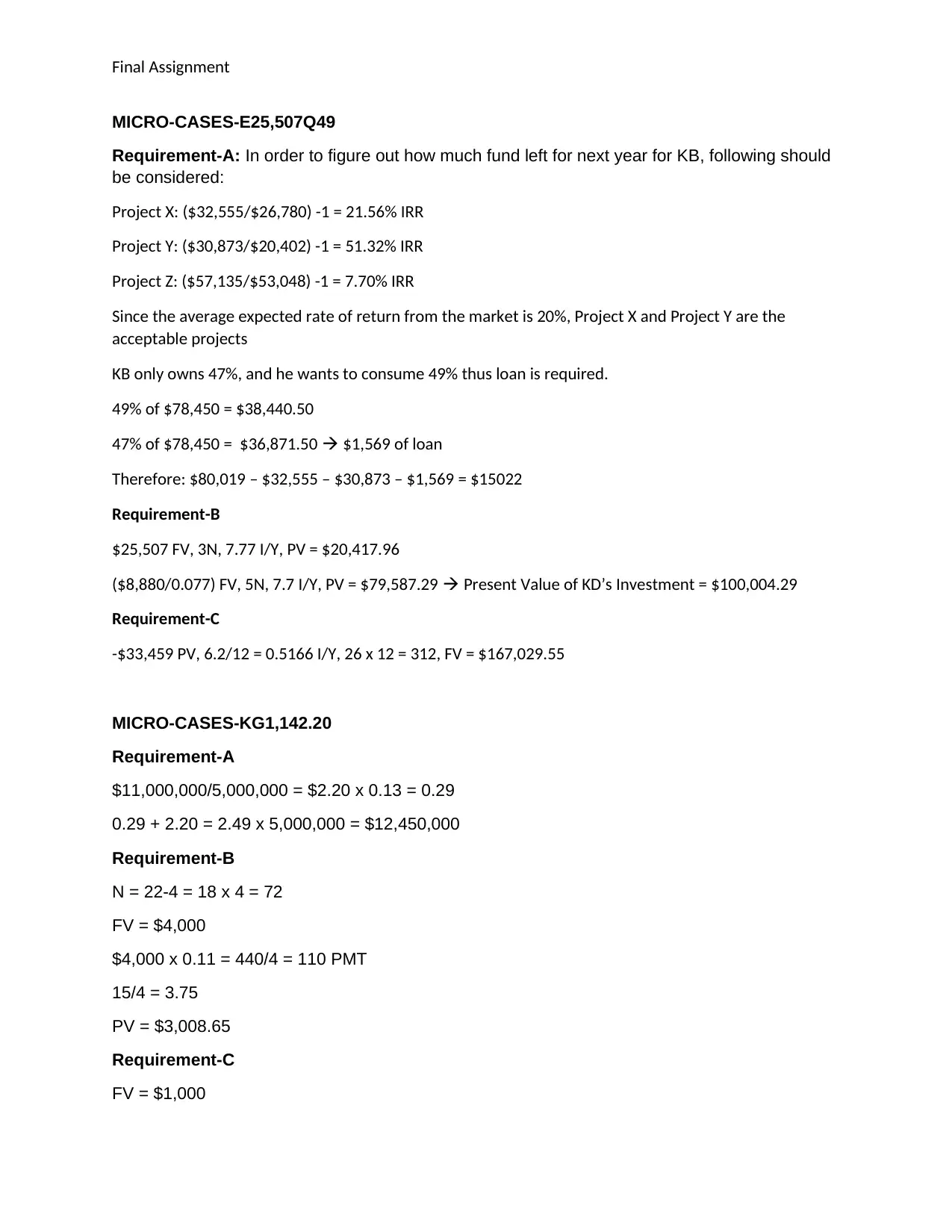
Final Assignment
MICRO-CASES-E25,507Q49
Requirement-A: In order to figure out how much fund left for next year for KB, following should
be considered:
Project X: ($32,555/$26,780) -1 = 21.56% IRR
Project Y: ($30,873/$20,402) -1 = 51.32% IRR
Project Z: ($57,135/$53,048) -1 = 7.70% IRR
Since the average expected rate of return from the market is 20%, Project X and Project Y are the
acceptable projects
KB only owns 47%, and he wants to consume 49% thus loan is required.
49% of $78,450 = $38,440.50
47% of $78,450 = $36,871.50 $1,569 of loan
Therefore: $80,019 – $32,555 – $30,873 – $1,569 = $15022
Requirement-B
$25,507 FV, 3N, 7.77 I/Y, PV = $20,417.96
($8,880/0.077) FV, 5N, 7.7 I/Y, PV = $79,587.29 Present Value of KD’s Investment = $100,004.29
Requirement-C
-$33,459 PV, 6.2/12 = 0.5166 I/Y, 26 x 12 = 312, FV = $167,029.55
MICRO-CASES-KG1,142.20
Requirement-A
$11,000,000/5,000,000 = $2.20 x 0.13 = 0.29
0.29 + 2.20 = 2.49 x 5,000,000 = $12,450,000
Requirement-B
N = 22-4 = 18 x 4 = 72
FV = $4,000
$4,000 x 0.11 = 440/4 = 110 PMT
15/4 = 3.75
PV = $3,008.65
Requirement-C
FV = $1,000
MICRO-CASES-E25,507Q49
Requirement-A: In order to figure out how much fund left for next year for KB, following should
be considered:
Project X: ($32,555/$26,780) -1 = 21.56% IRR
Project Y: ($30,873/$20,402) -1 = 51.32% IRR
Project Z: ($57,135/$53,048) -1 = 7.70% IRR
Since the average expected rate of return from the market is 20%, Project X and Project Y are the
acceptable projects
KB only owns 47%, and he wants to consume 49% thus loan is required.
49% of $78,450 = $38,440.50
47% of $78,450 = $36,871.50 $1,569 of loan
Therefore: $80,019 – $32,555 – $30,873 – $1,569 = $15022
Requirement-B
$25,507 FV, 3N, 7.77 I/Y, PV = $20,417.96
($8,880/0.077) FV, 5N, 7.7 I/Y, PV = $79,587.29 Present Value of KD’s Investment = $100,004.29
Requirement-C
-$33,459 PV, 6.2/12 = 0.5166 I/Y, 26 x 12 = 312, FV = $167,029.55
MICRO-CASES-KG1,142.20
Requirement-A
$11,000,000/5,000,000 = $2.20 x 0.13 = 0.29
0.29 + 2.20 = 2.49 x 5,000,000 = $12,450,000
Requirement-B
N = 22-4 = 18 x 4 = 72
FV = $4,000
$4,000 x 0.11 = 440/4 = 110 PMT
15/4 = 3.75
PV = $3,008.65
Requirement-C
FV = $1,000
Secure Best Marks with AI Grader
Need help grading? Try our AI Grader for instant feedback on your assignments.
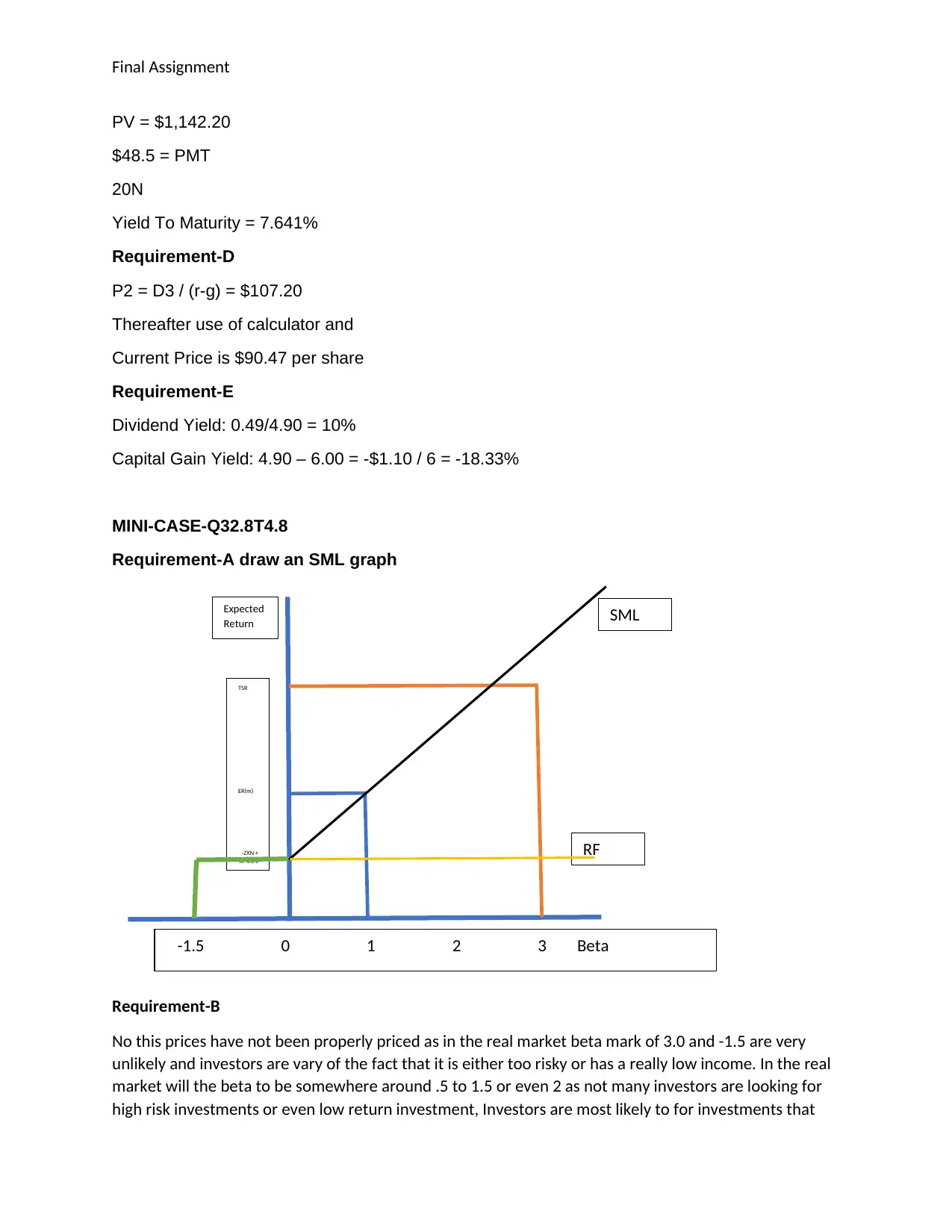
-1.5 0 1 2 3 Beta
SML
TSR
ER(m)
-ZXN +
Rf 4.8%
Expected
Return
RF
Final Assignment
PV = $1,142.20
$48.5 = PMT
20N
Yield To Maturity = 7.641%
Requirement-D
P2 = D3 / (r-g) = $107.20
Thereafter use of calculator and
Current Price is $90.47 per share
Requirement-E
Dividend Yield: 0.49/4.90 = 10%
Capital Gain Yield: 4.90 – 6.00 = -$1.10 / 6 = -18.33%
MINI-CASE-Q32.8T4.8
Requirement-A draw an SML graph
Requirement-B
No this prices have not been properly priced as in the real market beta mark of 3.0 and -1.5 are very
unlikely and investors are vary of the fact that it is either too risky or has a really low income. In the real
market will the beta to be somewhere around .5 to 1.5 or even 2 as not many investors are looking for
high risk investments or even low return investment, Investors are most likely to for investments that
SML
TSR
ER(m)
-ZXN +
Rf 4.8%
Expected
Return
RF
Final Assignment
PV = $1,142.20
$48.5 = PMT
20N
Yield To Maturity = 7.641%
Requirement-D
P2 = D3 / (r-g) = $107.20
Thereafter use of calculator and
Current Price is $90.47 per share
Requirement-E
Dividend Yield: 0.49/4.90 = 10%
Capital Gain Yield: 4.90 – 6.00 = -$1.10 / 6 = -18.33%
MINI-CASE-Q32.8T4.8
Requirement-A draw an SML graph
Requirement-B
No this prices have not been properly priced as in the real market beta mark of 3.0 and -1.5 are very
unlikely and investors are vary of the fact that it is either too risky or has a really low income. In the real
market will the beta to be somewhere around .5 to 1.5 or even 2 as not many investors are looking for
high risk investments or even low return investment, Investors are most likely to for investments that
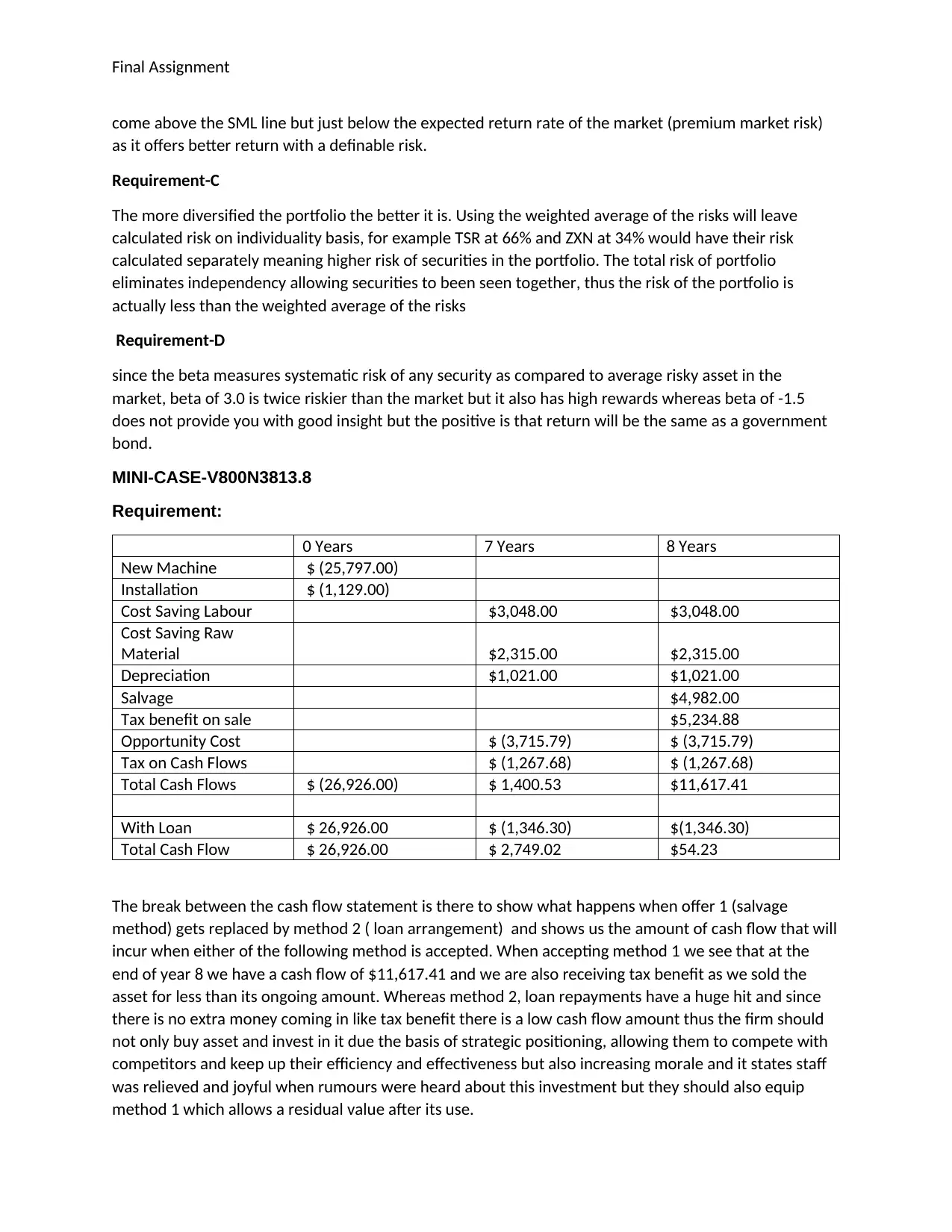
Final Assignment
come above the SML line but just below the expected return rate of the market (premium market risk)
as it offers better return with a definable risk.
Requirement-C
The more diversified the portfolio the better it is. Using the weighted average of the risks will leave
calculated risk on individuality basis, for example TSR at 66% and ZXN at 34% would have their risk
calculated separately meaning higher risk of securities in the portfolio. The total risk of portfolio
eliminates independency allowing securities to been seen together, thus the risk of the portfolio is
actually less than the weighted average of the risks
Requirement-D
since the beta measures systematic risk of any security as compared to average risky asset in the
market, beta of 3.0 is twice riskier than the market but it also has high rewards whereas beta of -1.5
does not provide you with good insight but the positive is that return will be the same as a government
bond.
MINI-CASE-V800N3813.8
Requirement:
0 Years 7 Years 8 Years
New Machine $ (25,797.00)
Installation $ (1,129.00)
Cost Saving Labour $3,048.00 $3,048.00
Cost Saving Raw
Material $2,315.00 $2,315.00
Depreciation $1,021.00 $1,021.00
Salvage $4,982.00
Tax benefit on sale $5,234.88
Opportunity Cost $ (3,715.79) $ (3,715.79)
Tax on Cash Flows $ (1,267.68) $ (1,267.68)
Total Cash Flows $ (26,926.00) $ 1,400.53 $11,617.41
With Loan $ 26,926.00 $ (1,346.30) $(1,346.30)
Total Cash Flow $ 26,926.00 $ 2,749.02 $54.23
The break between the cash flow statement is there to show what happens when offer 1 (salvage
method) gets replaced by method 2 ( loan arrangement) and shows us the amount of cash flow that will
incur when either of the following method is accepted. When accepting method 1 we see that at the
end of year 8 we have a cash flow of $11,617.41 and we are also receiving tax benefit as we sold the
asset for less than its ongoing amount. Whereas method 2, loan repayments have a huge hit and since
there is no extra money coming in like tax benefit there is a low cash flow amount thus the firm should
not only buy asset and invest in it due the basis of strategic positioning, allowing them to compete with
competitors and keep up their efficiency and effectiveness but also increasing morale and it states staff
was relieved and joyful when rumours were heard about this investment but they should also equip
method 1 which allows a residual value after its use.
come above the SML line but just below the expected return rate of the market (premium market risk)
as it offers better return with a definable risk.
Requirement-C
The more diversified the portfolio the better it is. Using the weighted average of the risks will leave
calculated risk on individuality basis, for example TSR at 66% and ZXN at 34% would have their risk
calculated separately meaning higher risk of securities in the portfolio. The total risk of portfolio
eliminates independency allowing securities to been seen together, thus the risk of the portfolio is
actually less than the weighted average of the risks
Requirement-D
since the beta measures systematic risk of any security as compared to average risky asset in the
market, beta of 3.0 is twice riskier than the market but it also has high rewards whereas beta of -1.5
does not provide you with good insight but the positive is that return will be the same as a government
bond.
MINI-CASE-V800N3813.8
Requirement:
0 Years 7 Years 8 Years
New Machine $ (25,797.00)
Installation $ (1,129.00)
Cost Saving Labour $3,048.00 $3,048.00
Cost Saving Raw
Material $2,315.00 $2,315.00
Depreciation $1,021.00 $1,021.00
Salvage $4,982.00
Tax benefit on sale $5,234.88
Opportunity Cost $ (3,715.79) $ (3,715.79)
Tax on Cash Flows $ (1,267.68) $ (1,267.68)
Total Cash Flows $ (26,926.00) $ 1,400.53 $11,617.41
With Loan $ 26,926.00 $ (1,346.30) $(1,346.30)
Total Cash Flow $ 26,926.00 $ 2,749.02 $54.23
The break between the cash flow statement is there to show what happens when offer 1 (salvage
method) gets replaced by method 2 ( loan arrangement) and shows us the amount of cash flow that will
incur when either of the following method is accepted. When accepting method 1 we see that at the
end of year 8 we have a cash flow of $11,617.41 and we are also receiving tax benefit as we sold the
asset for less than its ongoing amount. Whereas method 2, loan repayments have a huge hit and since
there is no extra money coming in like tax benefit there is a low cash flow amount thus the firm should
not only buy asset and invest in it due the basis of strategic positioning, allowing them to compete with
competitors and keep up their efficiency and effectiveness but also increasing morale and it states staff
was relieved and joyful when rumours were heard about this investment but they should also equip
method 1 which allows a residual value after its use.
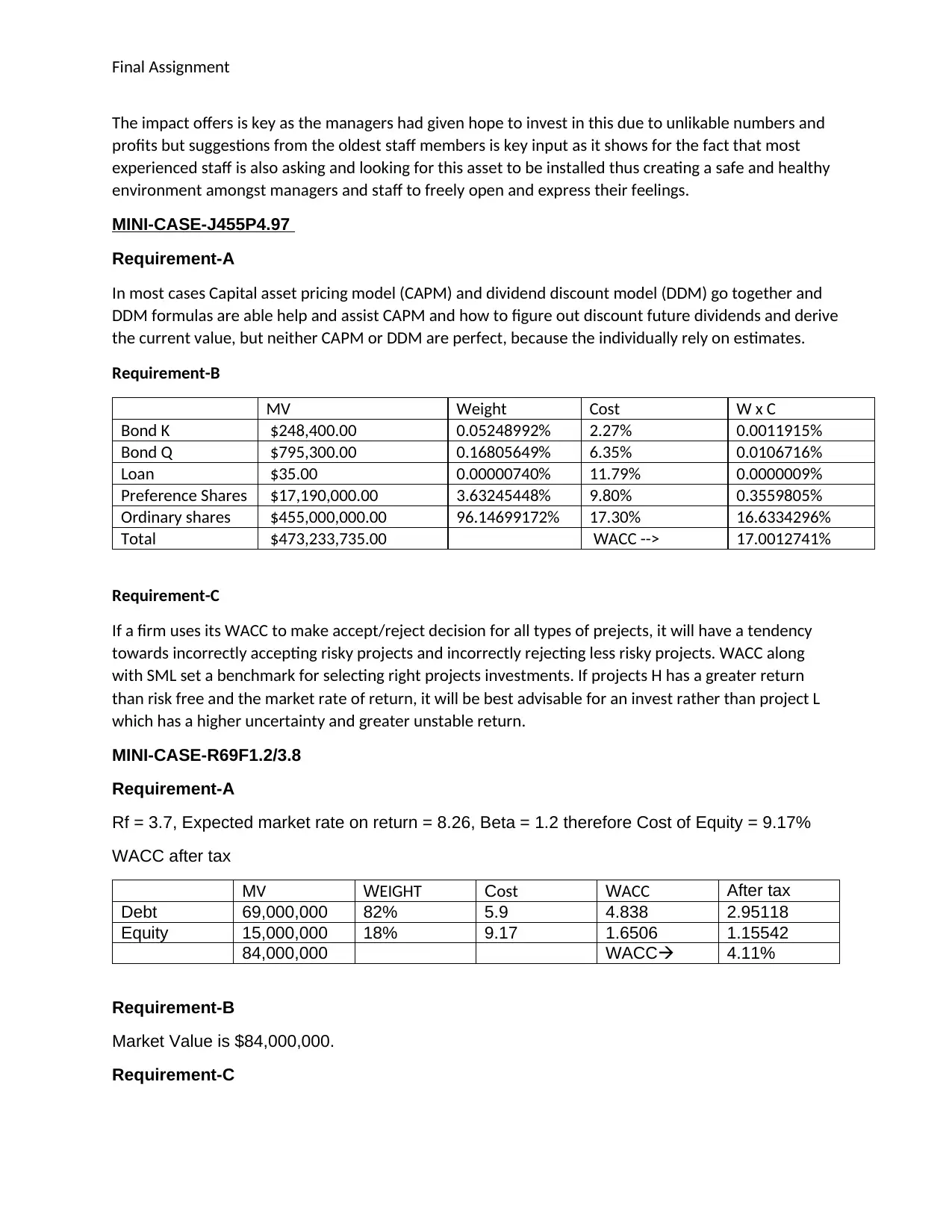
Final Assignment
The impact offers is key as the managers had given hope to invest in this due to unlikable numbers and
profits but suggestions from the oldest staff members is key input as it shows for the fact that most
experienced staff is also asking and looking for this asset to be installed thus creating a safe and healthy
environment amongst managers and staff to freely open and express their feelings.
MINI-CASE-J455P4.97
Requirement-A
In most cases Capital asset pricing model (CAPM) and dividend discount model (DDM) go together and
DDM formulas are able help and assist CAPM and how to figure out discount future dividends and derive
the current value, but neither CAPM or DDM are perfect, because the individually rely on estimates.
Requirement-B
MV Weight Cost W x C
Bond K $248,400.00 0.05248992% 2.27% 0.0011915%
Bond Q $795,300.00 0.16805649% 6.35% 0.0106716%
Loan $35.00 0.00000740% 11.79% 0.0000009%
Preference Shares $17,190,000.00 3.63245448% 9.80% 0.3559805%
Ordinary shares $455,000,000.00 96.14699172% 17.30% 16.6334296%
Total $473,233,735.00 WACC --> 17.0012741%
Requirement-C
If a firm uses its WACC to make accept/reject decision for all types of prejects, it will have a tendency
towards incorrectly accepting risky projects and incorrectly rejecting less risky projects. WACC along
with SML set a benchmark for selecting right projects investments. If projects H has a greater return
than risk free and the market rate of return, it will be best advisable for an invest rather than project L
which has a higher uncertainty and greater unstable return.
MINI-CASE-R69F1.2/3.8
Requirement-A
Rf = 3.7, Expected market rate on return = 8.26, Beta = 1.2 therefore Cost of Equity = 9.17%
WACC after tax
MV WEIGHT Cost WACC After tax
Debt 69,000,000 82% 5.9 4.838 2.95118
Equity 15,000,000 18% 9.17 1.6506 1.15542
84,000,000 WACC 4.11%
Requirement-B
Market Value is $84,000,000.
Requirement-C
The impact offers is key as the managers had given hope to invest in this due to unlikable numbers and
profits but suggestions from the oldest staff members is key input as it shows for the fact that most
experienced staff is also asking and looking for this asset to be installed thus creating a safe and healthy
environment amongst managers and staff to freely open and express their feelings.
MINI-CASE-J455P4.97
Requirement-A
In most cases Capital asset pricing model (CAPM) and dividend discount model (DDM) go together and
DDM formulas are able help and assist CAPM and how to figure out discount future dividends and derive
the current value, but neither CAPM or DDM are perfect, because the individually rely on estimates.
Requirement-B
MV Weight Cost W x C
Bond K $248,400.00 0.05248992% 2.27% 0.0011915%
Bond Q $795,300.00 0.16805649% 6.35% 0.0106716%
Loan $35.00 0.00000740% 11.79% 0.0000009%
Preference Shares $17,190,000.00 3.63245448% 9.80% 0.3559805%
Ordinary shares $455,000,000.00 96.14699172% 17.30% 16.6334296%
Total $473,233,735.00 WACC --> 17.0012741%
Requirement-C
If a firm uses its WACC to make accept/reject decision for all types of prejects, it will have a tendency
towards incorrectly accepting risky projects and incorrectly rejecting less risky projects. WACC along
with SML set a benchmark for selecting right projects investments. If projects H has a greater return
than risk free and the market rate of return, it will be best advisable for an invest rather than project L
which has a higher uncertainty and greater unstable return.
MINI-CASE-R69F1.2/3.8
Requirement-A
Rf = 3.7, Expected market rate on return = 8.26, Beta = 1.2 therefore Cost of Equity = 9.17%
WACC after tax
MV WEIGHT Cost WACC After tax
Debt 69,000,000 82% 5.9 4.838 2.95118
Equity 15,000,000 18% 9.17 1.6506 1.15542
84,000,000 WACC 4.11%
Requirement-B
Market Value is $84,000,000.
Requirement-C
Secure Best Marks with AI Grader
Need help grading? Try our AI Grader for instant feedback on your assignments.
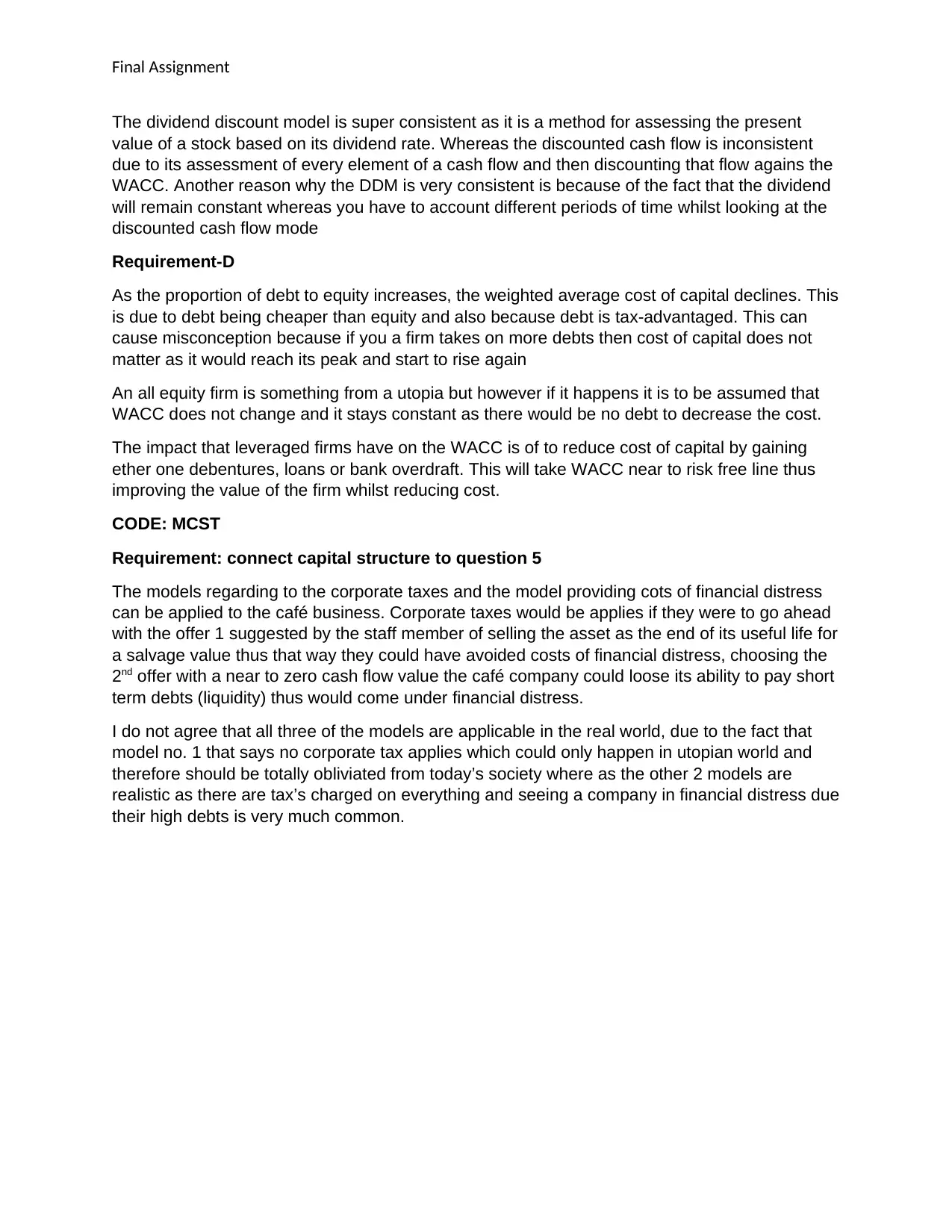
Final Assignment
The dividend discount model is super consistent as it is a method for assessing the present
value of a stock based on its dividend rate. Whereas the discounted cash flow is inconsistent
due to its assessment of every element of a cash flow and then discounting that flow agains the
WACC. Another reason why the DDM is very consistent is because of the fact that the dividend
will remain constant whereas you have to account different periods of time whilst looking at the
discounted cash flow mode
Requirement-D
As the proportion of debt to equity increases, the weighted average cost of capital declines. This
is due to debt being cheaper than equity and also because debt is tax-advantaged. This can
cause misconception because if you a firm takes on more debts then cost of capital does not
matter as it would reach its peak and start to rise again
An all equity firm is something from a utopia but however if it happens it is to be assumed that
WACC does not change and it stays constant as there would be no debt to decrease the cost.
The impact that leveraged firms have on the WACC is of to reduce cost of capital by gaining
ether one debentures, loans or bank overdraft. This will take WACC near to risk free line thus
improving the value of the firm whilst reducing cost.
CODE: MCST
Requirement: connect capital structure to question 5
The models regarding to the corporate taxes and the model providing cots of financial distress
can be applied to the café business. Corporate taxes would be applies if they were to go ahead
with the offer 1 suggested by the staff member of selling the asset as the end of its useful life for
a salvage value thus that way they could have avoided costs of financial distress, choosing the
2nd offer with a near to zero cash flow value the café company could loose its ability to pay short
term debts (liquidity) thus would come under financial distress.
I do not agree that all three of the models are applicable in the real world, due to the fact that
model no. 1 that says no corporate tax applies which could only happen in utopian world and
therefore should be totally obliviated from today’s society where as the other 2 models are
realistic as there are tax’s charged on everything and seeing a company in financial distress due
their high debts is very much common.
The dividend discount model is super consistent as it is a method for assessing the present
value of a stock based on its dividend rate. Whereas the discounted cash flow is inconsistent
due to its assessment of every element of a cash flow and then discounting that flow agains the
WACC. Another reason why the DDM is very consistent is because of the fact that the dividend
will remain constant whereas you have to account different periods of time whilst looking at the
discounted cash flow mode
Requirement-D
As the proportion of debt to equity increases, the weighted average cost of capital declines. This
is due to debt being cheaper than equity and also because debt is tax-advantaged. This can
cause misconception because if you a firm takes on more debts then cost of capital does not
matter as it would reach its peak and start to rise again
An all equity firm is something from a utopia but however if it happens it is to be assumed that
WACC does not change and it stays constant as there would be no debt to decrease the cost.
The impact that leveraged firms have on the WACC is of to reduce cost of capital by gaining
ether one debentures, loans or bank overdraft. This will take WACC near to risk free line thus
improving the value of the firm whilst reducing cost.
CODE: MCST
Requirement: connect capital structure to question 5
The models regarding to the corporate taxes and the model providing cots of financial distress
can be applied to the café business. Corporate taxes would be applies if they were to go ahead
with the offer 1 suggested by the staff member of selling the asset as the end of its useful life for
a salvage value thus that way they could have avoided costs of financial distress, choosing the
2nd offer with a near to zero cash flow value the café company could loose its ability to pay short
term debts (liquidity) thus would come under financial distress.
I do not agree that all three of the models are applicable in the real world, due to the fact that
model no. 1 that says no corporate tax applies which could only happen in utopian world and
therefore should be totally obliviated from today’s society where as the other 2 models are
realistic as there are tax’s charged on everything and seeing a company in financial distress due
their high debts is very much common.
1 out of 5
Your All-in-One AI-Powered Toolkit for Academic Success.
+13062052269
info@desklib.com
Available 24*7 on WhatsApp / Email
![[object Object]](/_next/static/media/star-bottom.7253800d.svg)
Unlock your academic potential
© 2024 | Zucol Services PVT LTD | All rights reserved.